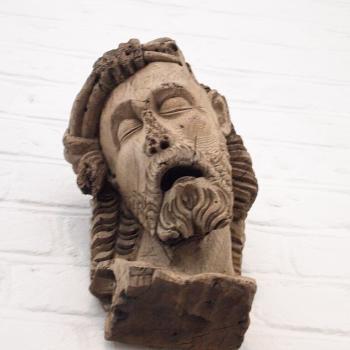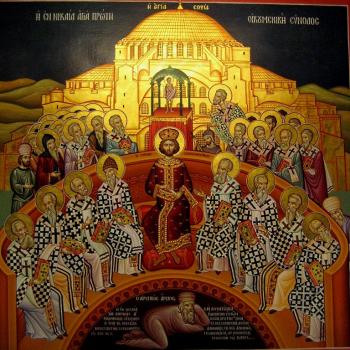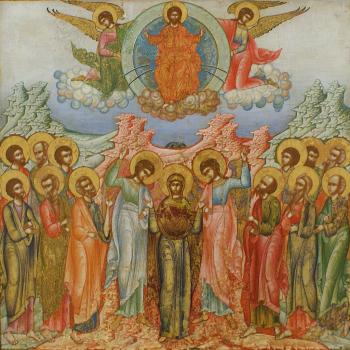
In their conflict with the Arians, those following the decrees of Nicea had to develop a sophisticated understanding of the incarnation in order to respond to Arian objections. For centuries, Christians used loose, if not ambiguous, theological explanations for the incarnation. This allowed subsequent generations to employ the same sources while holding differing conclusions. With the Arian crisis, this changed. While engaging the basic Christological outline which had been handed to them from previous generations, the Nicenes had to take on the difficult philosophical and theological work which their predecessors ignored, or at least failed to do.
One of the earliest and most significant Christological writers after Nicea was St. Athanasius. He consistently affirmed, throughout his writings, the divinity of Christ. But he struggled to deal with the implications of the incarnation. It was easy for him to portray the divinity of Christ, but he found it difficult to explain what it was for the Logos to become man. The general position he took is said to be described as “Logos-sarx.” With it, the presentation states that Word of God (Logos) assumed humanity by taking on human flesh (sarx), with a very loose understanding what that flesh entailed. The flesh served as the instrument for the work of the Logos. What was done, was done by the Logos through the flesh. The problem which emerged, the problem which would plague Athanasius and many like him, was the way in which the Logos could be associated with the flesh without leading to some sort of weakness in God himself. While St. Hilary of Poitiers would later try to resolve this question in his own unique way, Athanasius would rely upon the ambiguous nature of the Logos-sarx framework to provide some buffer to the Logos so as to show that the Logos remained inviolate.
Aloys Grillmeier, exploring the writings of Athanasius, suggests that Athanasius tried to solve the problem by promoting the difference between the flesh the Logos assumed and the Logos. The Logos assumed flesh, but he remained impassible in himself. The flesh, understood in an instrumental fashion, seems to lose some its human content; whether or not Christ had a human soul turned out to be mostly irrelevant. Nonetheless, what happened to flesh certainly could and should be seen as being appropriated to the Logos: “If the Logos is really to be considered as the sole motivating principle in Christ, then the decisive spiritual and moral acts must be assigned to him above all, in a way which appears to imply more than an appropriation after the manner of the communicatio idiomatum.” [1] But what lies behind this appropriation is the realization that the weakness of the flesh is not the weakness of the Logos; the Logos remains divine and impassible in that divinity. The instrument, the flesh, suffers, but the inner experience within the Logos is “weakened” if not outright denied
Athanasius displays a general tendency to weaken the character of certain of Christ’s inner experiences which might be attributed to a human soul so as to disassociate the Logos from them from the start. Thus Christ’s anguish was only ‘feigned,’ and not real anguish; his ignorance was no real ignorance, but only an ignorantia de jure, which was proper to the human nature from the start. Not only such a qualification relieve the pressure on the Logos itself, but it also raises the possibility of representing the human sarx of Christ as the subject of such affections as we should properly ascribe to the soul.[2]
G. Christopher Stead, similarly, sees Athanasius pointing out that any weakness discerned in the incarnate God-man was purely a weakness of the flesh, not the Logos in its divine nature:
In general, it remains true that Athanasius sees the Word as the true subject of the acts and experiences of Christ, except where these are clearly subject to human limitations and so are assigned to his ‘flesh’; and even then it is the Word himself who adopts them, as proper to the flesh which He assumed. [3]
Part of Athanasius’ concern lies in the way the incarnation was meant to deify humanity. The Logos assumed human flesh, God became man, so that man can become God. That is, he came to share with humanity the impassibility and immortality of the divine nature. For Athanasius, then, the Logos, assuming human flesh, overcomes the weakness of the flesh through his divine nature. What is weak in humanity, what is weak in the flesh, finds itself transcended by the divinity; seeing this in Christ, especially in and through the resurrection, we then find ourselves called to a similar impassibility, a similar glory:
Let no one then stumble at what belongs to man, but rather let a man know that in nature the Word Himself is impassible, and yet because of that flesh which He put on, these things are ascribed to Him, since they are proper to the flesh, and the body itself is proper to the Saviour. And while He Himself, being impassible in nature, remains as He is, not harmed by these affections, but rather obliterating and destroying them, men, their passions as if changed and abolished in the Impassible, henceforth become themselves also impassible and free from them for ever, as John taught, saying, ‘And ye know that He was manifested to take away our sins, and in Him is no sin. [4]
The problem with this framework is that without considering Jesus’s human soul, it is easy to disassociate the Logos from his suffering. This is why it was relatively easy for Athanasius to ignore Christ’s soul in his theological pursuits. When the soul of Christ is recognized, then the inner nature of the person of Christ experiences not just the divine reality as his own inner experience, but his human reality as well. St. Hilary, recognizing this, suggests humanity can transcend pain and grief while undergoing suffering. For Athanasius, the answer relies on the instrumental nature of the flesh. It was his, and so truly attributed to him, but yet what happened to the flesh did not touch the Logos according to its proper nature. Nothing which happened to his flesh is said to affect him in his divinity:
These things were so done, were so manifested, because He had a body, not in appearance, but in truth ; and it became the Lord, in putting on human flesh, to put it on whole with the affections proper to it; that, as we say that the body was His own, so also we may say that the affections of the body were proper to Him alone, though they did not touch Him according to His Godhead. [5]
Although there is a sense that the Logos, through its appropriation of the flesh, suffered, there is a greater sense that the Logos remained as it always was, impassible. The point of it all, the point of the Logos’s actions in history (which were real, as the incarnation was real) was to transform humanity by conquering the weakness of the flesh with flesh which he assumed unto himself:
If then He wept and was troubled, it was not the Word, considered as the Word, who wept and was troubled, but it was proper to the flesh; and if too He besought that the cup might pass away, it was not the Godhead that was in terror, but this affection too was proper to the manhood. And that the words ‘Why have You forsaken Me?’ are His, according to the foregoing explanations (though He suffered nothing, for the Word was impassible), is notwithstanding declared by the Evangelists; since the Lord became man, and these things are done and said as from a man, that He might Himself lighten these very sufferings of the flesh, and free it from them. [6]
Thus, Athanasius want to combat Gnosticism with its docetical approach to the passion by recognizing the reality of the flesh and what happened to it; but he sees the Logos influencing the flesh, transforming it, using it as a tool to bring about a change on all flesh. Within his life, Athanasius suggests, this could be seen by the way Jesus was never sick. He was, rather, the one who brought healing to those who are sick, so he himself could not and would not suffer such a malady:
If, then, once more, His body had fallen sick, and the word had been sundered from it in the sight of all, it would have been unbecoming that He who healed the diseases of others should suffer His own instrument to waste in sickness. For how could His driving out the diseases of others have been believed in if His own temple fell sick in Him ? For either He had been mocked as unable to drive away diseases, or if He could, but did not, He would be thought insensible toward others also. [7]
It is through the instrument of human flesh Christ was able to spread his deifying grace to the rest of humanity; the flesh was his, and it was the tool which he used to transform and change all flesh. But that meant he would have to demonstrate that change, at least in part, in his own life experiences. If deified flesh is to be impassible, if it is to transcend pain and grief, then the Logos first imparted such grace on his own flesh. Thus, to answer the Arians, Athanasius acknowledges the reality of what happened in the flesh, but he also believes that the subjectivity of the Logos was so central to the person of Jesus, that all which affected him was experienced by him in accordance to how his divinity would experience it. The flesh was the instrument which could have many things happen to it, but the impassible Logos was not pained or grieved, so that the Arian objection to the incarnation as indicating God was also pained and grieved was denied. It’s easy to see the problem here: in doing this, Athanasius undermined, if not relativized, the humanity of Jesus. Grillmeier says this is because of the Logos-sarx tradition which Athanasius uses for Christological understanding did not properly explore the humanity of Christ. The focus on the Logos overrides Jesus’ human experience:
There, in a typically Athanasian way, the power and immutability of the will of the Logos is emphasized in contrast to the weakness of the flesh. In any case, the nearness of the verbal Logos-sarx framework to the real is most striking at this point. The whole of the Athanasian picture of Christ is stamped with the immediacy of the Logos, which everywhere throws into relief the physical activity of the Logos, even though it Is at the same time mediated through the bodily reality of Christ’s humanity. Athanasius does not, of course, deny here that the human sarx of Christ performs its natural functions; these too are to be attributed to the Logos, but in a different way from those actions which are proper to the Godhead.[8]
To be clear, Athanasius does not deny a soul to Christ. He does not follow Apollinarius to such a conclusion. And though adding the soul might allow for a place for the pain and grief of the passion to be explored, as St. Hilary show us, the interest of the anti-Arian contingent found it important to show how humanity can become impassible and transcend such grief and suffering. For this reason, when it became clear that Jesus must have a human soul, Athanasius accepted such a conclusion without making alterations to his general theological perspective. He did not have to do so because the soul was irrelevant to Athanasius’s general perspective. What Athanasius sees is important is for us to recognize the work of the Logos and how that work influenced the flesh of Christ, and with it, imparted a similar deifying grace to humanity. Christ uses his passion to share his internal strength with the rest of humanity. Thus, Athanasius says throughout his ministry, Christ consistently showed the possibility of humanity transcending what we think it is capable of being:
For they are given to see, how He who did the works is the same as He who showed that His body was passible by His permitting it to weep and hunger, and to show other properties of a body. For while by means of such He made it known that, though God impassible, He had taken a passible flesh; yet from the works He showed Himself the Word of God, who had afterwards become man, saying, Though you believe not Me, beholding Me clad in a human body, yet believe the works, that you may know that “I am in the Father, and the Father in Me. “[9]
The Logos did not change, but his flesh, his humanity, took on and assumed more and more of the deifying grace over time, so that it can be said to grow, and manifest more of his Godhead to humanity:
Hence the Evangelist, speaking with cautious exactness, has mentioned stature in the advance; but being Word and God He is not measured by stature, which belongs to bodies. Of the body then is the advance; for, it advancing, in it advanced also the manifestation of the Godhead to those who saw it. And, as the Godhead was more and more revealed, by so much more did His grace as man increase before all men. [10]
While we might now be more accustomed to examine Christ, not from a High Christology like Athanasius, but a :ow Christology that begins with his humanity and sees what is revealed by it, this does not mean we have to disagree with Athanasius concerning his understanding of the effects of the deifying grace on Christ’s human nature. We often think of humanity as it exists apart from the deifying grace it was intended to have. Christ shows us the kingdom God. He shows us what humanity is supposed to be like. In him we see the effects of deifying grace. We are called to transcend the pain and suffering of the world. In Christ, it is overcome. If we deny this, then we deny the point of the incarnation itself. But if we accept that it is possible, then Athanasius, and Hilary like him, might offer us an important insight which we have otherwise lost. Clearly, more work needs to be done than we find in the works of Athanasius and Hilary, more work which takes into consideration the historical work of Christ and the humanity which is revealed in that work, but their intuition is important because it gives us hope that the pain and sorrow which we face does not have to last. It is not necessary for human existence. It can be overcome. We don’t have to romanticize suffering but recognize that it truly is a problem which the Logos came to solve.
[1] Aloys Grillmeier, Christ in Christian Tradition: From the Apostolic Age to Chalcedon (451). Trans. J.S. Bowden (New York: Sheed and Ward, 1965), 199-200.
[2] Aloys Grillmeier, Christ in Christian Tradition: From the Apostolic Age to Chalcedon, 202-3.
[3] G. Christopher Stead, “The Scripture and the Soul of Christ in Athanasius” in Vigiliae Christianae, Vol. 36, No. 3 (1982): 245.
[4] St. Athanasius, “Discourse III Against the Arians” in NPNF2(48): 412.
[5] St. Athanasius, “Discourse III Against the Arians,” 411.
[6] St. Athanasius, “Discourse III Against the Arians,”424.
[7] St. Athanasius, “Incarnation of the Word” in NPNF2(4):48.
[8] Aloys Grillmeier, Christ in Christian Tradition: From the Apostolic Age to Chalcedon, 200.
[9] St. Athanasius, “Discourse III Against the Arians,” 423.
[10] St. Athanasius, “Discourse III Against the Arians,” 422.
Stay in touch! Like A Little Bit of Nothing on Facebook.
If you liked what you read, please consider sharing it with your friends and family!













